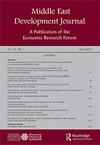Growth in Syria: losses from the war and potential recovery in the aftermath
IF 0.9
Q4 DEVELOPMENT STUDIES
引用次数: 1
Abstract
ABSTRACT This paper addresses three questions: (1) what would have been the growth and income trajectory of Syria in the absence of war; (2) given the war, what explains the reduction in economic growth; and (3) what potential growth scenarios for Syria there could be in the aftermath of war. Conflict impact estimates point to negative GDP growth of −12% on average over 2011–2018, with output contracting to about one-third of the 2010 level. In post-conflict simulation scenarios, the growth drivers are affected by the assumed levels of reconstruction assistance, repatriation of refugees, and productivity improvements associated with three political settlement outcomes: a baseline (Sochi-plus) moderate scenario, an optimistic (robust political settlement) scenario, and a pessimistic (de facto balance of power) scenario. Respectively for these scenarios, GDP per capita average growth in the next two decades is projected to be 6.1%, 8.2%, or 3.1%, assuming a final and stable resolution of the conflict.叙利亚的增长:战争的损失和战后的潜在复苏
本文解决了三个问题:(1)在没有战争的情况下,叙利亚的增长和收入轨迹会是什么;(2)考虑到战争,如何解释经济增长的下降;(3)战争结束后叙利亚的潜在增长前景。冲突影响估计表明,2011-2018年期间,GDP平均为负12%,产出萎缩至2010年水平的三分之一左右。在冲突后的模拟情景中,增长驱动因素受到与三种政治解决结果相关的重建援助、难民遣返和生产力改善的假设水平的影响:基线(索契+)温和情景、乐观(强劲的政治解决)情景和悲观(事实上的权力平衡)情景。在这些情况下,假设冲突最终稳定解决,未来20年的人均GDP平均增长率预计分别为6.1%、8.2%或3.1%。
本文章由计算机程序翻译,如有差异,请以英文原文为准。
求助全文
约1分钟内获得全文
求助全文

 求助内容:
求助内容: 应助结果提醒方式:
应助结果提醒方式:


